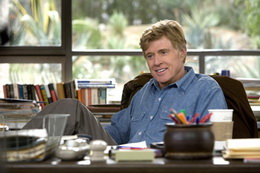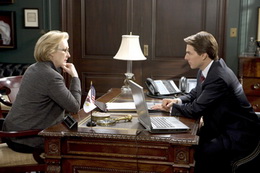
‘Lions for Lambs’ afflicted by horrible ‘Crash’-like disease
WANT FREE TIX TO “BEOWULF” IN 3D BEFORE IT COMES OUT? CLICK HERE NOW. As I walked away from the theater, I was completely dumbfounded by what I had just seen-was it respect that I felt for the man who had the balls to pass off an 88-minute civics lecture as a feature film? No, the movie wasn’t Al Gore’s global warming info-tainment spectacular “An Inconvenient Truth,” but it was dangerous in its own way. What I saw that night was the new Robert Redford-directed polemic “Lions For Lambs,” starring Redford, Tom Cruise, and Meryl Streep.”Lions for Lambs” is not a bold film because it points out hypocrisy, short-sightedness and a general lack of historical perspective when it comes to the current United States war policy-which it does, by the way. It is a bold film because of its stubborn adherence to shoehorning in every possible talking point about western civilization and its penchant for war, with nary a thought towards pacing, believable dialogue, a compelling plot, visual storytelling or character. And it is a dangerous film because it seems to carry on a discouraging new trend in movie-making. Like I said before, though, I almost begrudgingly admire Redford for letting it all hang out at blatantly as he has done here. Michael Moore makes subtler political films than this. Redford’s over-earnestness and lack of tasteful judgment has resulted in a movie that is beyond grandstanding. Hell, it’s beyond blustery; it’s blue in the face. “Lions for Lambs” is exhibitionist cinema for the post-“Crash” era, designed to tell us what we already know and somehow stir us out of our apathy simultaneously.That’s right, I blame Paul Haggis. Since “Crash,” his offensively puerile slice of sledgehammer obviousness, was rewarded [Best Picture in 2006][5], this brand of insulting preachiness has become more than merely acceptable. It is now, sadly, in vogue. Even though it raises legitimate points, Redford’s movie is equally offensive-not in message, but rather in method. Because of this, it just doesn’t work. We are too smart for this kind of cheap trickery. Like “Crash,” it sets up false expectations for flimsy character types whose discourse is limited to one specific topic and then dashes those expectations to the ground for its own didactic purpose. And, like “Crash,” it all happens in one day.The pawns in Redford’s game are two college students (Michael Peña and Derek Luke) who are moved to volunteer for the war, much to the horror of their anti-war professor (Redford). Forget that most young people today who volunteer to serve don’t join up out of idealistic duty-they’re broke just-out-of-high-schoolers who need to pay the rent. These two youngsters only exist to serve a purpose for manipulative screenwriter Matthew Michael Carnahan. Therefore, they make the decision to “do something” (which is the movie’s rallying call). To prove to themselves that they are actively involved in the American process-whether they agree that war is the right thing or not-they join up to fight it.The impetus for all the action (and inaction) that takes place in this talky film is as laughably contrived as plot devices get. The former “future of the Republican party,” Senator Jasper Irving (Tom Cruise, using his charm for evil) has a bold new plan to take the control of the “war on terror”-to hit Afghanistan really hard:by sending more U.S. troops after the Taliban. What’s even more ridiculous is that he’s so sure of his strategy (if you can call it that) that he invites ex-muckraker journalist Janine Roth (Meryl Streep) into his chambers to give her an exclusive as it happens. Guess who’s going in to fight?
Like I said before, though, I almost begrudgingly admire Redford for letting it all hang out at blatantly as he has done here. Michael Moore makes subtler political films than this. Redford’s over-earnestness and lack of tasteful judgment has resulted in a movie that is beyond grandstanding. Hell, it’s beyond blustery; it’s blue in the face. “Lions for Lambs” is exhibitionist cinema for the post-“Crash” era, designed to tell us what we already know and somehow stir us out of our apathy simultaneously.That’s right, I blame Paul Haggis. Since “Crash,” his offensively puerile slice of sledgehammer obviousness, was rewarded [Best Picture in 2006][5], this brand of insulting preachiness has become more than merely acceptable. It is now, sadly, in vogue. Even though it raises legitimate points, Redford’s movie is equally offensive-not in message, but rather in method. Because of this, it just doesn’t work. We are too smart for this kind of cheap trickery. Like “Crash,” it sets up false expectations for flimsy character types whose discourse is limited to one specific topic and then dashes those expectations to the ground for its own didactic purpose. And, like “Crash,” it all happens in one day.The pawns in Redford’s game are two college students (Michael Peña and Derek Luke) who are moved to volunteer for the war, much to the horror of their anti-war professor (Redford). Forget that most young people today who volunteer to serve don’t join up out of idealistic duty-they’re broke just-out-of-high-schoolers who need to pay the rent. These two youngsters only exist to serve a purpose for manipulative screenwriter Matthew Michael Carnahan. Therefore, they make the decision to “do something” (which is the movie’s rallying call). To prove to themselves that they are actively involved in the American process-whether they agree that war is the right thing or not-they join up to fight it.The impetus for all the action (and inaction) that takes place in this talky film is as laughably contrived as plot devices get. The former “future of the Republican party,” Senator Jasper Irving (Tom Cruise, using his charm for evil) has a bold new plan to take the control of the “war on terror”-to hit Afghanistan really hard:by sending more U.S. troops after the Taliban. What’s even more ridiculous is that he’s so sure of his strategy (if you can call it that) that he invites ex-muckraker journalist Janine Roth (Meryl Streep) into his chambers to give her an exclusive as it happens. Guess who’s going in to fight? The worst third of this awful movie has Redford lecturing a bright but disaffected student (Andrew Garfield) about living up to his potential. Here the film’s overtness reaches new levels of insanity, as Redford the director is formulating his thesis while Redford the actor is speaking it all aloud, and right to the camera. Not one moment in this entire segment feels real, and it ends in a bizarre way, with some off-topic easy jabs at our culture’s hollow celebrity fixation.With all the political and historical theory being posited in “Lions for Lambs,” and none of it particularly new or engaging, Meryl Streep comes the closest to actually creating a real character, and it’s almost at odds with the words that are coming out of her mouth. One might say a film set mostly in three rooms (with a couple awkward flashbacks) and involving just six major characters would have been better as a play, but I wouldn’t wish this on anyone who would have to feel uncomfortable sitting in the same room as the actors who have to say this stuff. Like a bad stand-up comedian, it’s uncomfortable when they’re bombing right in front of you-no pun intended.If this does indeed point to a new trend in absolutely transparent filmmaking, then “Lions for Lambs” is indeed a dangerous film. Think of all the wonderfully nuanced three-dimensional characters and depth in storytelling that would go out the window if all filmmakers wore their heart-not to mention their thesis statement-on their sleeve in this way. If I wanted speeches and well-rehearsed talking points, I’d watch a debate.
The worst third of this awful movie has Redford lecturing a bright but disaffected student (Andrew Garfield) about living up to his potential. Here the film’s overtness reaches new levels of insanity, as Redford the director is formulating his thesis while Redford the actor is speaking it all aloud, and right to the camera. Not one moment in this entire segment feels real, and it ends in a bizarre way, with some off-topic easy jabs at our culture’s hollow celebrity fixation.With all the political and historical theory being posited in “Lions for Lambs,” and none of it particularly new or engaging, Meryl Streep comes the closest to actually creating a real character, and it’s almost at odds with the words that are coming out of her mouth. One might say a film set mostly in three rooms (with a couple awkward flashbacks) and involving just six major characters would have been better as a play, but I wouldn’t wish this on anyone who would have to feel uncomfortable sitting in the same room as the actors who have to say this stuff. Like a bad stand-up comedian, it’s uncomfortable when they’re bombing right in front of you-no pun intended.If this does indeed point to a new trend in absolutely transparent filmmaking, then “Lions for Lambs” is indeed a dangerous film. Think of all the wonderfully nuanced three-dimensional characters and depth in storytelling that would go out the window if all filmmakers wore their heart-not to mention their thesis statement-on their sleeve in this way. If I wanted speeches and well-rehearsed talking points, I’d watch a debate.

